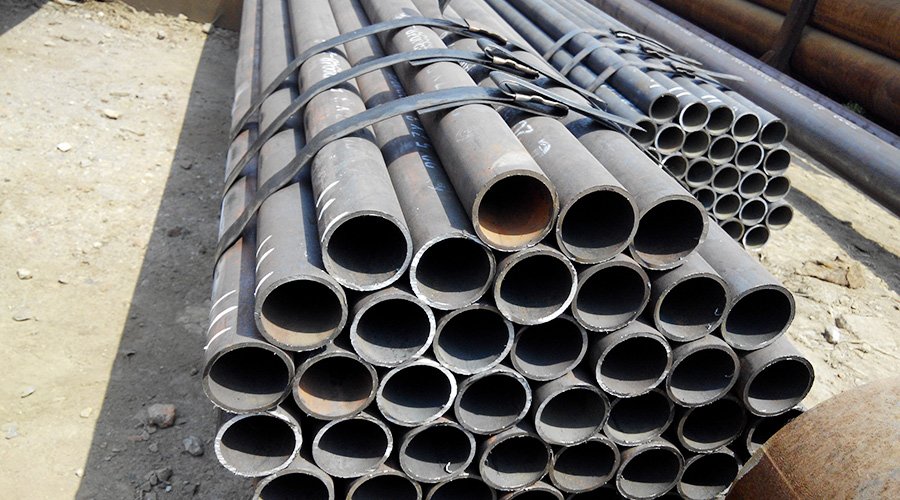Carbon steel pipe is made of steel ingot or solid round steel through perforation into rough pipe, and then hot rolled, cold rolled or cold drawn. Carbon steel pipe plays an important role in my country’s steel pipe industry.
Classification
Carbon steel pipe is divided into hot rolled and cold rolled (drawn) steel pipe.
Hot rolled carbon steel pipe is divided into general steel pipe, low and medium pressure boiler steel pipe, high pressure boiler steel pipe, alloy steel pipe, stainless steel pipe, petroleum cracking pipe, geological steel pipe and other steel pipes.
Cold rolled (drawn) carbon steel pipe includes carbon thin wall steel pipe, alloy thin wall steel pipe, stainless thin wall steel pipe and special shaped steel pipe in addition to general steel pipe, low and medium pressure boiler steel pipe, high pressure boiler steel pipe, alloy steel pipe, stainless steel pipe, petroleum cracking pipe and other steel pipes. The outer diameter of hot-rolled seamless pipe is generally greater than 32mm, and the wall thickness is 2.5-75mm. The outer diameter of cold-rolled seamless steel pipe can reach 6mm, and the wall thickness can reach 0.25mm. The outer diameter of thin-walled pipe can reach 5mm, and the wall thickness is less than 0.25mm. The dimensional accuracy of cold rolling is higher than that of hot rolling.
General carbon steel pipe: It is made of 10, 20, 30, 35, 45 high-quality carbon steel, 16Mn, 5MnV and other low-alloy structural steel or 40Cr, 30CrMnSi, 45Mn2, 40MnB and other alloy steels hot-rolled or cold-rolled. Seamless pipes made of low-carbon steel such as 10 and 20 are mainly used for fluid delivery pipelines. Seamless pipes made of medium-carbon steel such as 45 and 40Cr are used to manufacture mechanical parts, such as stress-bearing parts of automobiles and tractors. Generally, carbon steel pipes must ensure strength and flattening tests. Hot-rolled steel pipes are delivered in hot-rolled or heat-treated state; cold-rolled steel pipes are delivered in heat-treated state.
Preparation method
The raw material of carbon steel pipe is round tube billet, which is cut into billet with a length of about 1 meter by a cutting machine and sent to the furnace for heating via a conveyor belt. The billet is sent into the furnace for heating at a temperature of about 1200 degrees Celsius. The fuel is hydrogen or acetylene. The temperature control in the furnace is a key issue. After the round tube billet is taken out of the furnace, it must be pierced by a pressure piercing machine. Generally, the more common piercing machine is a conical roller piercing machine, which has high production efficiency, good product quality, large piercing diameter expansion, and can pierce a variety of steel types. After piercing, the round tube billet is successively rolled by three rollers, rolled continuously or extruded. After extrusion, it is removed from the tube and sized. The sizing machine uses a conical drill bit to rotate at high speed into the steel billet to punch holes to form a steel pipe. The inner diameter of the steel pipe is determined by the outer diameter length of the sizing machine drill bit. After sizing, the steel pipe enters the cooling tower and is cooled by water spray. After cooling, the steel pipe is straightened. After straightening, the steel pipe is sent to the metal flaw detector (or water pressure test) by the conveyor belt for internal flaw detection. If there are cracks, bubbles and other problems inside the steel pipe, they will be detected. After the quality inspection of the steel pipe, it must also pass strict manual selection. After the quality inspection of the steel pipe, the number, specification, production batch number, etc. are sprayed with paint. And it is hoisted into the warehouse by a crane.
Technical parameters
Carbon steel pipe is made of steel ingots or solid tube billets through perforation into rough tubes, and then hot rolled, cold rolled or cold drawn. Carbon steel pipes play an important role in my country’s steel pipe industry. According to incomplete statistics, there are about 240 carbon steel pipe production enterprises in my country, about 250 carbon steel pipe units, and an annual production capacity of about 4.5 million tons. In terms of caliber, <φ76 accounts for 35%, and <φ159-650 accounts for 25%. In terms of varieties, general-purpose pipes accounted for 1.9 million tons, accounting for 54%; petroleum steel pipes accounted for 760,000 tons, accounting for 5.7%; hydraulic props and precision pipes accounted for 150,000 tons, accounting for 4.3%; stainless pipes, bearing pipes, and automobile pipes accounted for 50,000 tons, accounting for 1.4%.
Specifications: The specifications of carbon steel pipes are expressed in millimeters of outer diameter*wall thickness.
What is Carbon Steel Pipe?

08
Apr

